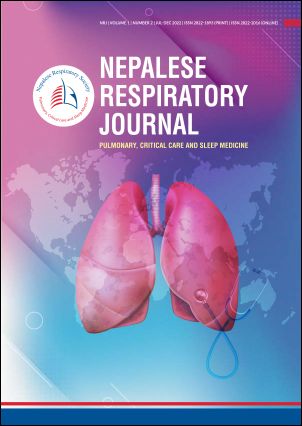Study of Point of Care Lung Ultrasound in Patients with Acute Respiratory Failure
DOI:
https://doi.org/10.3126/nrj.v1i2.54903Keywords:
COPD/Asthma, Dyspnea, PLAPS, Pneumonia, POCUSAbstract
Introduction: An acute dyspnea has been a common cause of hospital admission throughout history. When formulating a treatment plan based on limited clinical information, a rapid diagnosis is important. Bedside maneuvers and tests that deliver rapid and reliable results represent a cornerstone of diagnostics medicine.
Methods: This was a one-year cross-sectional research conducted at Chitwan Medical College Teaching Hospital. Consecutive patients with acute dyspnea whom were admitted for ≤ 6 hours were included in the study. A 5MHz micro-convex probe was used as the optimal single probe. Data entry and descriptive analysis were done in IBM SPSS version 20.0. Point estimate at 95% confidence interval was calculated along with frequency and descriptive statics.
Results: Pneumonia was the most common overall ultrasound diagnosis with combined frequency of 47%. With a Positive Predictive Value of 94.11% and Negative Predictive Value of 97.01%, anterior pneumonia exhibited a sensitivity of 94.11% and specificity of 97.11%. Similarly, Posterior Lateral Alveolar Points (PLAPS) pneumonia had a sensitivity of 94.11% and specificity of 98.08%, with a PPV of 94.11% and NPV of 98.80% respectively. The clinical accuracy for pulmonary edema was the greatest with 96.77%. while COPD/asthma had least accuracy with 81.25%.
Conclusions: POCUS of the lung, has a high sensitivity and specificity, especially for evaluation of acute causes of dyspnea such pulmonary edema and pneumonia. It is more sensitive than Chest X ray alone and should be integrated while making clinical diagnosis.
Downloads
Downloads
Published
How to Cite
Issue
Section
License
This license enables reusers to distribute, remix, adapt, and build upon the material in any medium or format, so long as attribution is given to the creator. The license allows for commercial use.




